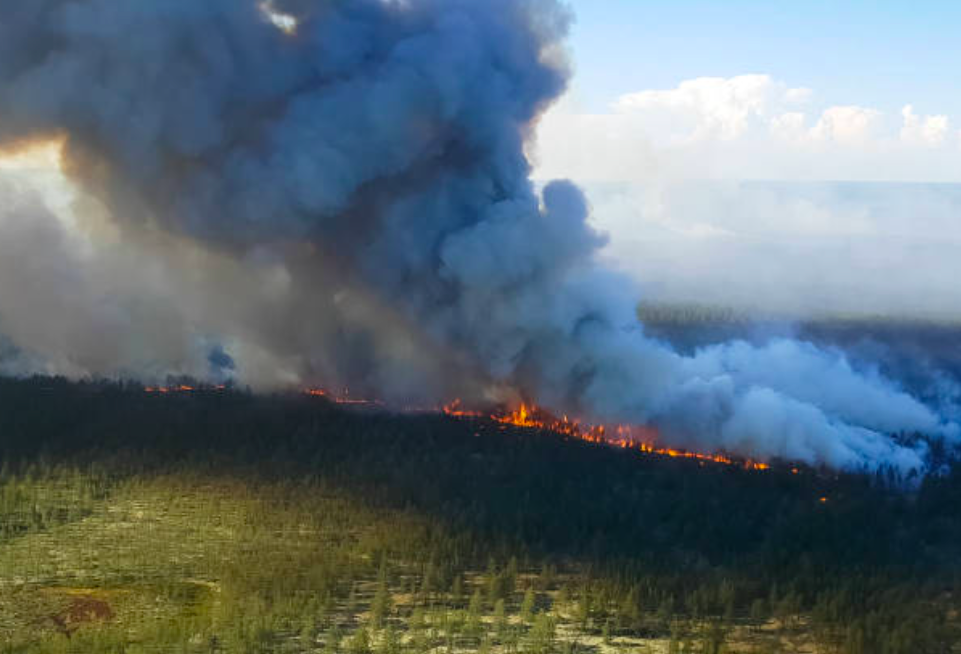When thinking about Siberia, what comes to mind? Most think of a vast, snowy tundra with freezing temperatures. However, due to the rapid warming of the Arctic, there have been extreme wildfire seasons within Siberia. An estimated 23 million acres have burned in this region since 1982, but nearly half of that has occurred within the last four years; this information indicates that Siberia may be nearing a threshold where extreme fires become typical.
The Siberian Arctic is characterized by a vast expanse of forest, tundra, peatlands, and *permafrost. However, due to global warming, this permafrost has started to melt. When this occurs, the microbes within this frozen layer begin to decompose the plant materials found within it. As a result, this process releases carbon dioxide, methane, and other harmful greenhouse gasses into the atmosphere. Although this thawing layer won’t instantaneously release a catastrophic explosion of carbon, this trapped carbon will slowly leak out from the permafrost located all over the Arctic. In time, it will substantially add to the amount of carbon that humans have already added to the atmosphere by burning fossil fuels, increasing industrial activity, through rapid globalization, etc. Furthermore, an evolving concern is the risk of diseases and bacteria being released from the thawing ground – in some areas this has already occurred and the released diseases have hospitalized locals.
On top of increasing carbon emissions and furthering global warming, the thawing of permafrost is detrimental to humans and ecosystems. The increased emissions can be hazardous for humans, as well as plants and animals, to breathe and as a result, it can be deadly if an immense amount of greenhouse gasses are inhaled. In addition, permafrost is structurally important in Siberia and many other Arctic regions. Its thawing is detrimental to local ecosystems and their biodiversity as it can lead to landslides, erosion, ground subsidence, and saltwater encroachment. The impacts of permafrost can also be seen in the day-to-day life of citizens as the topographical degradation of land is challenging to farmers who have to relocate to more suitable farming areas, pipelines in the Yamal Peninsula are at risk of damage, and civilian homes are being deformed due to thawing permafrost. All across the Arctic, ecosystems are shifting from carbon sinks to carbon sources, meaning that instead of absorbing greenhouse gasses the systems are releasing them.
Specifically in Siberia, the wildfires in this region are often the result of thawing permafrost and the burning of decayed organic material in **peat. Over the past four decades, the Arctic has been warming about four times faster than the global average. The results of this can be explicitly seen within Siberia where recent summers have been marked by extreme temperatures, sometimes as high as 100 degrees Fahrenheit or 38 degrees Celsius. On top of that, factors that affect wildlife risks such as the length of the growing season and air and surface temperatures have also increased over the past decades. What is extremely concerning for this region is that these uncharacteristic fires may become the norm for the region, in contrast to its typically snowy, frigid weather; this change in climate will drastically affect local ecosystems and people living in these areas and on a larger scale will lead to further destruction as global temperatures continue to rise.
As the global temperature continues to trend upward, other regions around the world may undergo similar situations like Siberia where they experience the catastrophic impacts of climate change. In order to fight back against global warming and work towards reversing its detrimental effects within Siberia, government leaders in Russia have stated that Russia will be carbon neutral by 2060 and they are working towards shifting to renewable energy sources and the development of carbon sinks to absorb carbon dioxide. While this goal is far-reaching, it may not be entirely feasible for Russia since the Climate Action Tracker (an independent science publication) has judged Russia’s current strategy as “critically insufficient”, the lowest of their ratings, and the fact that around only 0.2% of Russia energy is produced from solar or wind energy. Regardless of this, many other countries around the world are also struggling to keep up with increasing greenhouse gas emissions while simultaneously trying to reach a carbon-neutral state.
Nevertheless, it is vital that all countries devote more effort to lowering their greenhouse gas emissions and preventing global warming before the effects become too extreme and irreversible, which would affect all of us. In the Siberian region specifically, it is urgent that efforts be made to prevent the continuous melting of permafrost due to its detrimental effects; citizens have little time to wait as their livelihoods are at critical risk.
* Permafrost: a permanently frozen layer on or under Earth’s surface composed of soil and plant/animal material
** Peat: an accumulation of partially decayed vegetation or organic matter
Bibliography:
Fountain, Henry. “A Warming Siberia, Wracked by Wildfires, Nears a Crucial Threshold.” The New York Times, 3 November 2022, https://www.nytimes.com/2022/11/03/climate/siberia-fires-climate-change.html. Accessed 11 December 2022.
Murdock, Ryan. “Climate Change and Siberia: No time for climate inaction.” Harvard International Review, 28 January 2022, https://hir.harvard.edu/climate-change-and-siberia-no-time-for-continued-climate-inaction/. Accessed 11 December 2022.
Yaffa, Joshua. “The Great Siberian Thaw.” The New Yorker, 17 January 2022, https://www.newyorker.com/magazine/2022/01/17/the-great-siberian-thaw. Accessed 11 December 2022.

